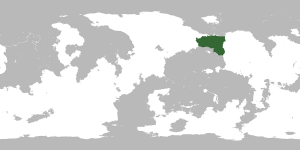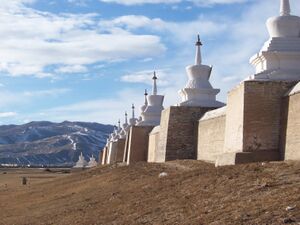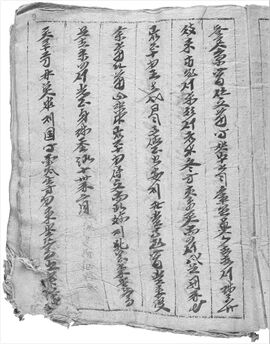Tergynia
Democratic Republic of Tergynia Template:MongolUnicodeTemplate:MongolUnicodeTemplate:MongolUnicode
Template:MongolUnicodeTemplate:MongolUnicode ᡋᡇᡎᡑ ᠨᠠᡅᠷᠠᡏᡑᠠᡍ ᠠᠷᠠᡑᡒᡅᠯᠰᠠᠨ ᡐᡄᠷᡎᡄᠨ ᡎᡇᠷ Bugd Nairamdah Aradčilsan Tergen Gor | |
|---|---|
Motto: Assorted screaming | |
 Land controlled by the Republic of Tergynia shown in green | |
| Capital | Daudbalgas |
| Largest city | Chichihari |
| Official languages | Standard Tergynian |
| Recognised regional languages | |
| Official script | Clear script |
| Ethnic groups | |
| Religion (2021) |
|
| Demonym(s) | Tergynian |
| Government | Unitary semi-presidential republic |
| Muŋhgerel | |
| Ishaš | |
| Tsaur | |
| Legislature | State Great Hural |
| Formation | |
| 1933 | |
| Area | |
• Total | [convert: invalid number] (?) |
• Water (%) | 100 |
| Population | |
• 2021 estimate | |
• 2021 census | 25,385,000 (?) |
• Density | 65.3/km2 (169.1/sq mi) (?) |
| GDP (nominal) | 2021 estimate |
• Total | |
• Per capita | |
| Gini (2021) | medium |
| HDI (2019) | high · ? |
| Currency | Tugrug (⊼) (TRT-Tugrug)) |
| Time zone | UTC+8 (Tergynian Standard Time) |
| Date format | Template:Vunblist |
| Driving side | right |
| Calling code | +88 |
| Internet TLD | |
Tergynia, officially the Republic of Tergynia (RT), is a country in Cancodia. It is bordered to the north by Omniabstracta, to the east by the Meridan Sea, to the south by Lanhuanan, and to the west by the Nuntic Ocean. The capital city is Daudbalgas and the largest city and historic capital is Chichihari. Tergynia is a pluralistic society with its 25 million people comprising of various ethnolinguistic groups, the largest among these being the Tergyn people followed by significant minorities of Otoghuz and Aicuns. Tergynia is 76% Manichaean, with the remainder being irreligious, adhere to a form of Tengrism, or follow other faiths.
The first recorded settled civilizations in Tergynia were the !Saka and the !Sogdians that established city states and kingdoms along the western coast. Central and northern Tergynia was home to various nomadic groups including the proto-Tergyns, Rimians, and Aicunic peoples. The eastern coast was inhabited by seafaring !Tangut and !Yeniseian societies that lasted until the 1100s. Tergyn steppe nomads and Manichaean Otoghuz nomads from Central Cancodia conquered the mostly sedentary societies along the coasts and formed various steppe empires, such as the !Xianbei, !Rouran, and !Otuzoghuz. In the 1100s, Horbun Gurkhan established the Tergyn Empire that spanned from West Tergynia to Faulknia. The Tergynian revolution in 1933, which overthrew the Tergyn Khaganate, established a multi-party democracy.
Etymology
The name Tergynia means the "Land of the Tergynians" in Latin. The origin of the Tergynian word "Tergen" comes from the Tergynian word for cart "Tereg".
History
Prehistory
placeholder
Antiquity
The !Saka and !Sogdian tribes established a network of city states and kingdoms along Tergynia's western coast that interacted with various civilizations in the Nuntic sea. On the eastern coast, some !Yeniseian and !Tangut peoples established sea-faring societies. In between the seas, proto-Tergyn and Rimians lived together on the steppe, until the Rimians were driven from the steppe and into the mountains for a variety of reasons, including conflict with the proto-Tergyns. In 200 BC, one of the only remaining !Yeniseian steppe nomads established the !Xiongnu steppe confederacy, which layed the foundations for a string of nomadic empires to occupy central and eastern Tergynia.
Middle Ages
By the 300s, the !Eastern Iranic kingdoms were in decline due to constant warfare, conflict with nomadic groups, and climate change. The first instance of Qijaric migration into the territory of Tergynia was around 400 when Xuroghur tribes migrated into southwestern Tergynia. In the 800s, various Manichaean Qijaric tribes fled central Cancodia after being forced out by other Qijaric tribes that converted to Islam and reorganized themselves into the Otoghuz Confederation in southwestern Tergynia. The Otoghuz absorbed the Xuroghur and conquered the declining !Sogdian and !Saka kingdoms.
Tergyn Empire
placeholder
Post-empire
placeholder
Tergyn Khaganate
In 1583, Ormus of the Gurbad united the Tergyn tümens once more and reorganized the Tergyn confederation into the Tergyn Khaganate. Because of the Gurbad's !Mongolic origins, the court language is based on !Middle Mongol with some Old Tergyn loanwords because of its prestigious use in the Tergyn Empire.
Tavantömör, son of Ölziit Khagan, was fascinated by the culture and structure of the Lanhuanese civilization. This fascination fueled his ambition to reform the Tergyn Khaganate into a centralized, settled empire. When Tavantömör was elected by the huraldai to be khagan in 1668, he started a series of reforms to establish permanent settlements throughout the khaganate and encouraged settled tribes to take up agriculture. Tavantömör hired skilled advisors from Lanhuanan to plan cities, establish codified laws, found universities, and to introduce agriculture to the settlements. Due to several disastrous zuds that killed many tribes' livestock, several tribes moved into the settlements and took up agriculture. Initially, Tavantömör was hesitant about forcing unwilling tribes to settle, however when the Merged raided the settlement of Böh, Tavantömör issued a decree to forcefully settle the Merged and all remaining fully-nomadic tribes. This ignited a 10 year civil war that saw nearly half of the noyons take up arms against the khagan. The rebelling tribes managed to win the siege of Chichihari and forced the Khagan and his allies to retreat to the city of Hardalai on the Nuntic coast. The rebelling armies sieged Hardalai, but due to fresh reinforcements, better fortifications, and firearms from Lanhuanan, the rebels were forced to retreat to their camps. Tavantömör lead his army to engage the demoralized rebels and completely decimated them. All of the rebelling noyons were executed by horses trampling on them. Tavantömör, with the support of his reformist allies, abolished the huraldai system, which was the start of the absolutist rule of his dynasty. He exiled most of the remaining fully-nomadic tribes into the northern mountains, where they still remain. Tribes that practiced transhumance were treated with great leniency.
Republic (1933–present)
placeholder
Tergynian Revolution
placeholder
Tergynian Civil War
placeholder
Geography
Landscape and climate
Biodiversity
Environment
Political geography
Politics
Government
Administrative divisions
Foreign relations
Trade relations
Sociopolitical issues and human rights
Military
Economy
Wealth in Yinshan
Economic growth
Tergynia in the global economy
Class and income inequality
Science and technology
Historical
Modern era
Infrastructure
Telecommunications
Transport
Water supply and sanitation
Demographics
Ethnic groups
Languages
Standard Tergyn is the standardized literary language used by the Tergynian government and media. It descended from Gurbad Tergyn language, the court language used by the Tergyn Khaganate which was a mix of the Chichihari dialect of !Middle Mongol and Old Tergyn. Language reforms in the Republican era introduced more native Tergyn words into the vocabulary in order to better represent the vernacular languages of the !Daur. Vernacular Tergyn dialects are not as influenced by Gurbad as the standard language is.
Urbanization
Template:Most populous cities in the Democratic Republic of Tergynia
Education
Health
Religion
Culture

Tourism in Tergynia
Literature

Philosophy
Cuisine
Music
Cinema
Fashion
Sports
Boikoo tarkbei and poolie tarkbei are considered to be national sports of Tergynia. Soccer is very popular in every region of Tergynia.
See also
Notes
References
Further reading
- Articles with short description
- Convert errors
- Pages using infobox country or infobox former country with the symbol caption or type parameters
- Tergynia
- Tergynian-speaking countries and territories
- Countries in Cancodia
- Member states of the Kerbin Assembly
- Democratic Republic of Tergynia
- Republics
- Countries on Kerbin



